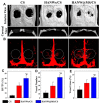Hybrid and Single-Component Flexible Aerogels for Biomedical Applications: A Review
- PMID: 38275842
- PMCID: PMC10815221
- DOI: 10.3390/gels10010004
Hybrid and Single-Component Flexible Aerogels for Biomedical Applications: A Review
Abstract
The inherent disadvantages of traditional non-flexible aerogels, such as high fragility and moisture sensitivity, severely restrict their applications. To address these issues and make the aerogels efficient, especially for advanced medical applications, different techniques have been used to incorporate flexibility in aerogel materials. In recent years, a great boom in flexible aerogels has been observed, which has enabled them to be used in high-tech biomedical applications. The current study comprises a comprehensive review of the preparation techniques of pure polymeric-based hybrid and single-component aerogels and their use in biomedical applications. The biomedical applications of these hybrid aerogels will also be reviewed and discussed, where the flexible polymeric components in the aerogels provide the main contribution. The combination of highly controlled porosity, large internal surfaces, flexibility, and the ability to conform into 3D interconnected structures support versatile properties, which are required for numerous potential medical applications such as tissue engineering; drug delivery reservoir systems; biomedical implants like heart stents, pacemakers, and artificial heart valves; disease diagnosis; and the development of antibacterial materials. The present review also explores the different mechanical, chemical, and physical properties in numerical values, which are most wanted for the fabrication of different materials used in the biomedical fields.
Keywords: biocompatible aerogels; flexible hybrid aerogels; flexible scaffolds; flexible single-component aerogels; mechanical properties; sustained drug delivery; tissue engineering.
Conflict of interest statement
The authors declare no conflicts of interest.
Figures














References
-
- Mazrouei-Sebdani Z., Begum H., Schoenwald S., Horoshenkov K.V., Malfait W.J. A review on silica aerogel-based materials for acoustic applications. J. Non-Cryst. Solids. 2021;562:120770. doi: 10.1016/j.jnoncrysol.2021.120770. - DOI
-
- Parale V.G., Lee K.-Y., Park H.H. Flexible and transparent silica aerogels: An overview. J. Korean Ceram. Soc. 2017;54:184–199. doi: 10.4191/kcers.2017.54.3.12. - DOI
-
- Zhong L., Chen X., Song H., Guo K., Hu Z. Highly flexible silica aerogels derived from methyltriethoxysilane and polydimethylsiloxane. New J. Chem. 2015;39:7832–7838. doi: 10.1039/C5NJ01477H. - DOI
Publication types
LinkOut - more resources
Full Text Sources

